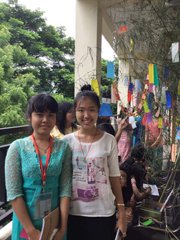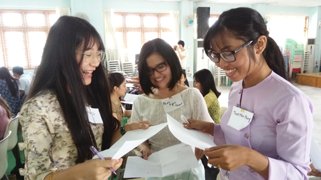Japanese-Language Education in Myanmar
Yangon University of Foreign Languages
SATO Naoki
1. Entering the Japanese Language Department
It is only possible to study the Japanese language as a regular subject in higher educational institutions at Yangon University of Foreign Languages (hereinafter “YUFL”), where I am dispatched, or its sister college, Mandalay University of Foreign Languages (hereinafter “MUFL”). Currently, in addition to the Japanese language, English, Chinese, Korean, French, Germany, Thai and Russian exist at the academic discipline or department level, and of those languages, Japanese is the second most popular after English.

Students holding a Tanabata (Star Festival) event at YUFL
Whether students can continue on to university students depends on how many points out of a total of 600 they obtain in the high school graduation exam (referred to in Myanmar as the 10th Standard Examination), and this determines the university and academic discipline that a student can advance to (other things factored into the decision are the student’s examination subjects, the student’s wishes, the region and so on). In the case of the December 2017 enrollees, the English course accepted students within the 524-477 point range and the Japanese course accepted students within the 506-466 point range. These are extremely high scores, and demonstrate that the courses attract outstanding students.
Additionally, one thing that has changed in the past few years is the emergence of students who say “We will enroll in the Japanese course because we want to learn the Japanese language.” That may seem obvious, but previously, because the passing grade for the English course and the passing grade for the Japanese course did not overlap (the lowest score to enter the English course was higher than the highest grade to enter the Japanese course), it gave rise to a phenomenon in which Japanese did not rate as a desired course even if the points obtained were too high. As a result, because the previous format involved enrolling in the course you were eligible for once your results were known, most students who enrolled in the Japanese course did so because they had nowhere else to go. This is gradually changing, and cases are emerging of students enrolling in the Japanese course because they really want to learn Japanese, or they like Anime. This is something I am very happy about, and it is also changing the motivation of the teachers on the front line.
2. Graduate School
I mainly oversee classes in the graduate school.
Myanmar’s graduate school master’s program (MA) is a three-year program. Prior to the two-year Master’s degree there is a one-year preliminary course.
Currently at YUFL there is one student enrolled in the MA preliminary course, and one first-year Master’s student. At MUFL there are currently nine first-year and one second-year Master’s students.
The students have a variety of reasons for progressing to the Master’s program, but many did so after considering their careers, and more than a few students advanced to the Master’s program at the recommendation of their parents. Students in the Master’s course undertake an in-depth study of the Japanese language, and so they inevitably acquire the expertise needed as Japanese-language teachers. It is my hope that if better teachers are produced, it will increase the quality of Japanese-language education and lead to more people learning the Japanese language too.
Realistically, however, it is difficult to survive as a teacher alone, and partly due to that some students consider going to work for Japanese companies, or working as interpreters or translators in the corporate and other sectors. Going forward, it will no doubt be necessary to think about where people completing the Master’s program will work.
3. Japanese-Language Education Seminar
Twice a year (in spring and autumn) I hold a seminar for Japanese-language teachers. University students and graduate students who are hoping to become teachers also take part, so the seminars become venues for teachers to interact regardless of age or institution. 97 teachers from YUFL and 67 teachers from MUFL took part in the spring 2018 seminar, and they held sessions where they thought about Japanese-language education together while interacting, cooperating and encouraging one another.

A shot from the seminar at MUFL
The sessions included comparing Japanese grammar and expressions with Burmese while taking a look at how they differ, and getting experience of new Japanese-language teaching methods as a way of coming up with better lessons. Traditional teaching methods remain very strongly rooted in Myanmar, but I feel I might have helped the participants experiencing something new as a result of them actually trying out new teaching methods. I survey the seminar participants each time and ask them to come up with topics they would like to see covered in the seminars. I am planning to create initiatives that enable us to consider those themes together so it becomes possible to respond to a large number of those topics in detail.
4. Japanese-Language Teacher Circles
There are two teachers’ associations in Yangon – the Japanese Language Teacher Association, Myanmar and the Japanese Language Teacher Association, Yangon. The former is a teachers’ association comprising mainly individuals from Myanmar, and it holds regular study groups. These study groups mostly follow a pattern of sharing the individual problems that the working teachers are facing and working to resolve them, and I serve as a lecturer.
The latter association, the Japanese Language Teacher Association, Yangon is a teachers’ association comprising mainly Japanese nationals, and it is also notable for holding regular dinner meetings. There is much that can be learned and discovered from interactions between Japanese people involved in Japanese-language education in the same region. An initiative is also underway to adopt challenges that have surfaced in the course of these candid conversations as themes for regular study groups, and I genuinely sense the results that circles of teachers produce.
I believe that expanding associations such as these will serve to further advance Japanese-language education. In Mandalay, it is yet to take on the appearance of a teachers’ association, but dinner meetings that bring together local Japanese-language teachers are becoming regular events. Partly because there are not many Japanese people in Mandalay, their connection is strong, and I have expectations going forward.
- What We Do Top
- Arts and Cultural Exchange [Culture]
- Japanese-Language Education Overseas [Language]
- Japanese-Language Education Overseas [Language] Top
- Learn Japanese-language
- Teach Japanese-language
- Take Japanese-Language Test
- Know about Japanese-language education abroad
- The Japanese-Language Institute, Urawa
- The Japanese-Language Institute, Kansai
- Japanese-Language Programs for Foreign Specified Skilled Worker Candidates
- Japanese Language Education for Japanese Children Resident Overseas and for the Descendants of Migrants
- Archives
- Japanese Studies and Global Partnerships [Dialogue]
- JF digital collection
- Other Programs / Programs to Commemorate Exchange Year
- Awards and Prizes
- Publications
